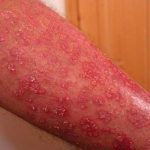 Is a systemic nutritional wasting disease caused by a deficiency of vitamin B3 (niacin).
Is a systemic nutritional wasting disease caused by a deficiency of vitamin B3 (niacin).
A vitamin B3 (nicotinamide) deficiency that may be a cause of major mental symptoms such as delusions and impaired thinking, as well as physical symptoms such as dermatitis.
The disease due to deficiency of the vitamin niacin and the amino acid tryptophan.
A nutritional deficiency disease produced by insufficient intake of niacin and/or nicotinic acid in the diet.
A disease caused by a deficiency of niacin and characterized by dermatitis, mental disorders, diarrhea, and weakness.
A nutritional deficiency disease resulting from a severe deficiency of niacin is characterized by symptoms of diarrhea, dermatitis, dementia, and, finally, death.
A disease caused by a deficiency of nicotinic acid, riboflavine and pyridoxine from the vitamin B complex, where patches of skin become inflamed, and the person has anorexia, nausea and diarrhoea.
Skin itchiness, diarrhoea and dementia, resulting essentially from a deficiency of the vitamin niacin.
Niacin deficiency disorder.
Disease caused by deficiency of niacin or tryptophan in the diet or by a defect m the metabolic conversion of tryptophan to niacin; it is characterized by dermatitis, inflammation of the tongue, diarrhea, and emotional and mental symptoms including depression, disorientation, and confusion. Treatment includes the administration of niacin and tryptophan and a well-balanced diet containing other vitamins.
A disorder resulting from a severe deficiency of niacin (vitamin B3). Symptoms include dermatitis, diarrhea, and dementia. If left untreated, pellagra usually causes death. Deficiency diseases such as pellagra are rare in the United States and other developed countries.
A nutritional disease due to a deficiency of nicotinic acid (a B vitamin). Pellagra results from the consumption of a diet that is poor in either nicotinic acid or the amino acid tryptophan, from which nicotinic acid can be synthesized in the body. It is common in corn-eating communities. The symptoms of pellagra are scaly dermatitis on exposed surfaces, diarrhea, and depression.
A potentially fatal nutritional disorder caused by a deficiency of vitamin B complex (niacin). The symptoms are dermatitis, diarrhoea and dementia. The deficiency occurs mainly in poor people in developing countries where maize is a prime constituent of the diet. Nicotinic acid in maize is in a bound form that the consumer cannot utilize. Further, maize is deficient in the amino acid, tryptophan, from which the human body can make nicotinic acid.
The clinical consequences of profound niacin deficiency characterized by cutaneous, gastrointestinal, mucosal, and neurological symptoms. It is found in regions of the world where malnutrition is endemic.
A potentially life-threatening condition caused by a lack of niacin (a component of the vitamin B complex), leading to symptoms such as dermatitis, diarrhea, and dementia.
Pellagra predominantly manifests in impoverished rural populations across certain regions globally, such as parts of India, where individuals heavily rely on maize as a staple. The body struggles to absorb the majority of niacin from maize unless it’s treated with an alkali like limewater. Additionally, maize lacks sufficient tryptophan, an amino acid that transforms into niacin within the body.
Conditions like carcinoid syndrome (which accelerates the degradation of tryptophan) and Crohn’s disease (which hampers the uptake of tryptophan from the small intestine) can lead to the development of pellagra.
Initial indications encompass weakness, weight reduction, fatigue, melancholy, restlessness, and skin inflammation and itchiness in sun-exposed areas. During acute episodes, the affected skin might develop oozing blisters, while the tongue becomes vivid red, swollen, and distressingly sore.
The diagnosis relies on the patient’s health status and dietary background. Typically, a combination of regular niacin consumption and a diverse diet leads to a resolution.
A long-term deficiency disease mainly found in populations that primarily consume maize. It’s linked to a lack of riboflavin (vitamin B2), pyridoxin (B6), and nicotinic acid (B7) in the diet. Early symptoms include weakness, back pain, and digestive issues. As it progresses, a skin rash appears, causing the skin to turn dry and flaky. In extreme cases, it can lead to nerve problems, including muscle spasms, paralysis of the legs, and cognitive issues. This condition is also known as mal de la rosa, mal de sole, maidismus, psilosis pigmentosa, Asturian leprosy, and Alpine scurvy.
